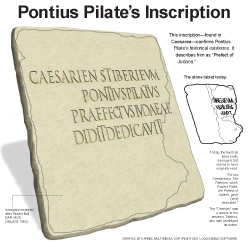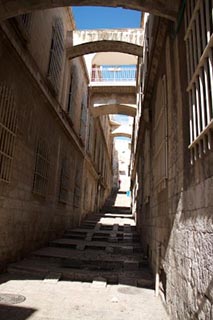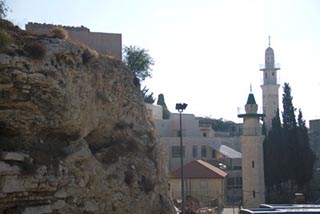15:1 chief priests See note on 11:18.
Pilate Refers to Pontius Pilate, who governed Judaea for the Roman Empire circa ad 26–36. As the emperor Tiberius’ prefect in the region, Pilate was responsible for resolving both civil and criminal cases, and he had authority to carry out capital punishments.
 Political Leaders in the New Testament Table
Political Leaders in the New Testament Table
15:2 Are you the king of the Jews The charge that the temple leaders had formulated in 14:55–65 was blasphemy. They probably translated Jesus’ claim to be the Messiah into an idiom that Pilate would understand—and one that they hoped would prompt him to act (compare v. 32).
15:4 charges they are bringing against you Other than the treason implied by the title “king of the Jews,” Mark doesn’t identify specific charges against Jesus (compare v. 26).
15:7 with the rebels It is unclear from Mark’s gospel whether Barabbas was a rebel himself or was merely imprisoned with the rebels (compare note on Matt 27:16).
15:10 because of envy Indicates that Pilate did not take seriously the trumped-up charges of treason.
15:14 What evil has he done Though Pilate seems to be defending Jesus’ innocence, his question is double-edged: If he doesn’t condemn Jesus’ claim to kingship, Rome could view him as endorsing that claim.
15:15 flogged A typical preliminary to crucifixion.
15:16 the governor’s residence Pilate’s permanent seat of government was the maritime city of Caesarea, located 35 miles from Jerusalem. He resided in Jerusalem
located 35 miles from Jerusalem. He resided in Jerusalem during times of festival when a more visible Roman presence was desirable for maintaining order.
during times of festival when a more visible Roman presence was desirable for maintaining order.
cohort Refers to one-tenth of a Roman legion—equally approximately 600 to 1,000 men.
15:21 Cyrene A city in North Africa where Jews had lived since the third century bc.
father of Alexander and Rufus It is unclear why Mark identifies Simon’s sons. Mark’s original audience may have been familiar with them.
to carry his cross The condemned normally had to carry the crossbeam to the place of execution (Mark 8:34). Simon’s enlistment implies that Jesus already was too weak to do so.
15:22 Golgotha An Aramaic word meaning “skull.” The precise location of this place is uncertain.
15:23 wine mixed with myrrh Meant to alleviate some of the pain of crucifixion.
he did not take Compare 14:25.
15:24 divided his clothes among themselves by casting lots An allusion to Psa 22:18, which describes the psalmist’s suffering at the hands of the wicked. This statement may indicate Jesus’ nakedness or near nakedness.
 Messianic Psalms Table
Messianic Psalms Table
15:25 the third hour Jesus’ experience of the Roman justice system is extremely fast-paced: The approximate time of the events are: The trial occurred at 6 a.m. (Mark 15:1), His crucifixion at 9 a.m., and His death at 3 p.m. (v. 34).
15:26 The king of the Jews Confirms the Roman justification for Jesus’ death (compare v. 2
15:27 one on his right and one on his left Similar to the description in Isa 53:9 (compare Mark 10:37).
15:29 reviled him, shaking their heads Similar to the description in Psa 22:7.
15:33 darkness came Parallels the cosmic signs that Jesus said would herald the Son of Man’s return (Mark 13:24).
15:34 Eloi, Eloi, lema sabachthani Jesus cries out in Aramaic; Mark provides the Greek translation.
My God, my God, why have you forsaken me The opening line of Psa 22, which Mark references elsewhere (Mark 15:24, 29)—demonstrating that Jesus epitomizes suffering itself, and the desperation felt with it, in this moment. See Psa 22:1 and note.
15:35 Behold, he is summoning Elijah The bystanders misunderstand Jesus’ cry of “Eloi! Eloi!” as “Eli(jah)! Eli(jah)!” They do not realize that the figurative Elijah—John the Baptist—has already come and gone (compare Mark 9:12–13).
15:38 the curtain of the temple This could refer to the outer curtain, which shielded the entrance to the sanctuary. Heavenly imagery was embroidered on the outer curtain, forming an appropriate parallel to the heavens tearing open at Jesus’ baptism (1:10). Alternatively, it could indicate the inner veil, which hid the divine presence in the most holy place (holy of holies); this might parallel the Holy Spirit descending at Jesus’ baptism.
15:39 Truly this man was God’s Son Jesus’ identity is fully revealed upon His death (compare note on Isa 53:12). At three key events in Mark’s Gospel—Jesus’ baptism, transfiguration, and crucifixion—a voice confirms that Jesus is God’s Son. Here, it is no longer God the Father proclaiming Jesus’ identity, but instead a non-Jewish person—confirming Jesus’ ministry and mission to Gentiles (see note on Mark 13:10).
15:40 Magdalene This designation likely refers to a resident of the Galilean town of Magdala.
the mother of James the younger and Joses Possibly refers to Jesus’ mother, since the names of two of Jesus’ brothers are mentioned (see 6:3 and note). But it may also refer to Jesus’ aunt or another woman named Mary.
15:43 Arimathea A town of Judaea, probably identical to Ramah in the ot.
the council Refers to the Sanhedrin (see note on 14:55), which heard the first trial of Jesus (14:55–65).
(see note on 14:55), which heard the first trial of Jesus (14:55–65).
15:44 he was already dead Jesus died over the course of six hours (vv. 25, 34). Under normal circumstances, crucifixion could extend over multiple days.
15:46 tomb that had been cut from the rock Tombs cut from rock were more expensive to excavate and maintain than graves in the ground. They generally were family tombs. This action parallels Isa 53:9.

|
About Faithlife Study BibleFaithlife Study Bible (FSB) is your guide to the ancient world of the Old and New Testaments, with study notes and articles that draw from a wide range of academic research. FSB helps you learn how to think about interpretation methods and issues so that you can gain a deeper understanding of the text. |
| Copyright |
Copyright 2012 Logos Bible Software. |
| Support Info | fsb |
 Loading…
Loading…





